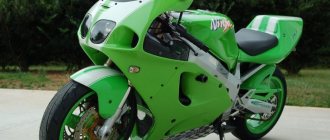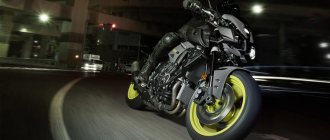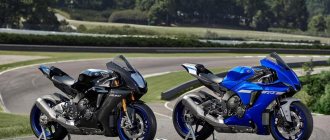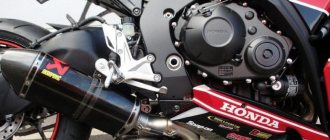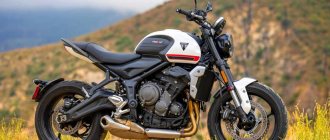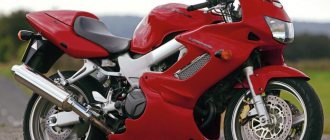Test drive ApriliaRSV Mille 1000 R, Ducati999
All motorcycle lovers have heard and know about the unusual status and high prestige of the Ducati brand. At the same time, few people can clearly explain what is unusual and exclusive hidden under the fairing of the Italian motorcycle. I have been looking for the answer to this question for a very long time. I read articles about the advantages of a two-cylinder engine over a four-cylinder engine, articles about the advantages of the Ducati layout, compared technical characteristics... and did not find any convincing explanation for myself. The first signs of clarity on this issue appeared in my head when I started riding the ring. I rode an ordinary Japanese Kawasaki, and the shortcomings that were inherent in my motorcycle were theoretically absent from the Ducati. I received final confirmation of my thoughts on the day of this test, when we tried to find out what the thoroughbred Italians Aprilia RSV 1000R and Ducati 999 are like.
We decided to test two “Italians” with two-cylinder V-liter engines to get an impression of a) how big the “gap” is between them and the Japanese “fours”; b) how different they can be from each other. After all, both of these models are sportbikes in a “civilian” version, which means that they are a priori suitable for everyday driving and for going to the race track on weekends. After all, this is what thoughtful owners of “sports” do: they race on the track, and simply ride on the roads, enjoying not the speed, but the motorcycle itself.
Experienced riders know that power alone does not provide true riding pleasure. Real pleasure from a motorcycle can only be obtained when the chassis matches the engine, when the braking dynamics are adequate to the acceleration dynamics, when the ergonomics do not force you to think about yourself. A motorcycle can be powerful or not very powerful, small or large, asphalt or off-road, but, in any case, it must be harmonious, then you will like it. But still, engine power is the most attractive line in the technical characteristics table of any sportbike; it is sought with the eyes first of all. So let's look at the design of both motorcycles, starting with the engine.
The Aprilia power unit was developed with the assistance of Rotax specialists and has a magnesium crankcase, which in itself is not repeated by anyone else in the world. The two-cylinder engine with a cylinder angle of 60 degrees and four valves per cylinder, having evolved, was inherited from the previous generation of RSV. In 2006, it received valves of increased diameter and, accordingly, an exhaust manifold of increased cross-section. The newly reprogrammed fuel injection system now ensures exhaust purity according to Euro3 standards. The inertial charging system, with an air intake located in the center of the fairing between the headlights, adds another 3% of power at maximum speed. The two-cylinder V-twin engine by its nature generates strong vibration. Aprilia engineers wisely decided that they did not have a Harley (which holds vibrations in high esteem) and equipped the engine with a balancer shaft.
The Ducati 999 engine is also traditional, but with a camber angle of 90 degrees. An engine of this configuration has been installed on these motorcycles for many years, with the front cylinder lying horizontally and the rear cylinder, accordingly, standing strictly vertical. Therefore, this motor is most often called L-shaped. The traditional four valves per cylinder for modern engines are driven by an unconventional desmodromic mechanism. The essence of this mechanism is that the valves are opened by the camshaft, as usual, but they are closed by special cams, and not by springs. The advantage of this valve drive is precise adherence to valve timing: at high speeds there is no inertial hanging of the valves. Once upon a time, back on air-cooled carburetor engines, the desmodromic mechanism made it possible to do without a red zone on the tachometer, the engine was not afraid of over-torque, it simply lost power, and you were forced to change gears. Modern Ducatis traditionally have no redline, but this is deceiving, the electronic rev limiter still kicks in at 10,500 rpm.
The Ducati frame is so original that it has already become a kind of calling card of the company. Welded from chrome-molybdenum steel, the spatial structure has not changed its appearance for many years, although it is constantly being improved. The Aprilia frame is more modern, it is assembled from cast aluminum elements. The front forks of both motorcycles have the same diameter of the moving pipes, equal to 43 millimeters. The only difference is in the suppliers: while the Ducati has a Showa fork, the RSV has the iconic Ohlins as standard. The rear shock absorbers on both bikes are from Showa.
The brakes, of course, are from the world's best manufacturer, Brembo. The braking mechanisms are almost the same on both motorcycles, the only difference being that on the Aprilia they have a radial caliper mount, and on the Ducati they have an “old-fashioned” traditional one. Even the rims on both cars are of a similar design and were made by the Italian wheel couturier Marchesini.
All these technical nuances and design features actually say nothing about how these motorcycles ride and why they are loved or not loved.
For the first time in my life, when I rode a Ducati, I also had a passenger on my back! An interesting feeling: I couldn’t drive away from a traffic light normally. I take off smoothly, but as soon as the tachometer needle reaches 3000 rpm, the motorcycle “goats up”, I have to close the gas and engage the next gear. But even in the next gear he is happy to goat when the engine spins up to 5 thousand. It is clear that the passenger loading the rear is in the way, but this is a real manifestation of the notorious “traction from the very bottom.” The next time I went for the test. I was riding alone, and since such a motorcycle needs to be tested on a track, my path lay through the entire city, to “Chaika”. When driving around the city, a very pleasant moment for both “twos” (in Ducati this factor is more pronounced) is that the motorcycle is narrow and its ability to “climb” between cars is the same as that of another moped.
The dynamics are like those of a motorcycle. What motorcycle? It is impossible to answer this question unequivocally. It seems that the slightly boosted Japanese 600 drives just like this liter Italian. Ducati's dynamics cannot be compared with any GSX-R1000 or Yamaha R1. He pulls, but doesn’t lift his hands, there is no explosive character at all. The L-shaped two has softened reactions to gas operation and the engine does not provoke jerking and mischief as sharply as the Japanese “liter”. Of course, if you get on this motorcycle after the 400 or after the Java, you will be amazed by its dynamics. But if after the Japanese “liter”, then if you try the standard “999th”, you will most likely be disappointed. But what will really fascinate you is the chassis. The motorcycle is incredibly stable both on asphalt waves and on cracks. The stability and stability of the motorcycle is the same as that of a sports motorcycle with stiff springs and clamped shock absorbers, but when driving through potholes, the energy intensity of the suspension is so good that there is no smell of any super-hard “cond” at all. What's really hard is the seat and clutch lever. The clutch is equipped with a hydraulic drive, and still, after twenty minutes of “squeezing” around the city, two fingers of the left hand are no longer able to squeeze the lever; you have to work with four fingers, and this is unpleasant.
What about Aprilia? The seating position is a little more civil, the clip-ons are higher, the seat is softer. If you don’t know what kind of motorcycle you’re riding, it’s impossible to tell the “fifth point” difference in the operation of the suspensions of these two motorcycles. But the clutch is no longer so tight. In general, the bike from Noale gives more comfort, but as a compatriot and ideological ally, it has a character similar to Ducati. The engine also pulls smoothly and confidently after 2 thousand, just like Ducati, power increases with increasing speed. The operating range of the engine is similar. In general, if you close your eyes to the “little things”, then for the driver these are two absolutely identical engines. The minor differences in this case are sound and vibration. The Ducati sound is a combination of a tricky valve train and a loud dry clutch. Anyone can listen to the sound of a working Dukat clutch at home. You just need to take an old Soviet alarm clock and ask it to ring: the same measured, metallic clang is made by an Italian mechanism worth 20 thousand “cu.” Aprilia, equipped with a “wet” clutch and a traditional valve drive, does not make unusual sounds.
What is the advantage of a two-cylinder motorcycle over an inline four-cylinder? Firstly, the motorcycle is noticeably narrower, and this is a significant advantage for daily use in a large city. It’s easier to “sneak through” traffic jams. When turning, it does not trace the asphalt with plastic. The four-cylinder doesn’t seem to work either, but this is achieved by the fact that the engine is located higher in the frame. Therefore, a narrow motorcycle is easier to control, and this is immediately noticeable (and pleasant!), even in city driving mode. Secondly, the two-cylinder engine has a small crankshaft. And the crankshaft is a very massive part that retains inertia well, that is, a gyroscope, which prevents the motorcycle from quickly turning into a turn. The smaller the size and weight of the gyroscope, the easier it is to shift the motorcycle. Thirdly, a less “revving” engine with a smoothly increasing power allows you to start opening the gas earlier in a turn and more accurately control the beginning of the moment the drive wheel stalls. Each layout has its own “highlights”, but instead of an in-depth study of the theory, it is still much more interesting to find out whether these theoretical advantages can be experienced in real track conditions.
Once you drive around the ring for the first time, everything becomes clear. Ducati is a motorcycle sharply tailored for sport. It was originally designed as a sports equipment and it is not for nothing that it won so many championship titles in the WSBK championship. Every detail, which in the city still raised doubts about convenience, on the ring proved the justification of its use. The large dial tachometer is in the peripheral vision zone, and the speedometer, located behind the tachometer, closer to the tank, is no longer in the field of view. In the city, in order to find out about the speed, you had to take your eyes off the road, but the fact is that on the roundabout this is unnecessary, so they removed the unnecessary information “out of sight.” The narrow tank, with its bizarre shape, demonstrates the wonders of ergonomics. All manufacturers have more or less convenient knee pads, but this is the first time I’ve come across a tank molded to fit the forearm! When you move in a deep bend, hanging down, your elbow finds such comfortable support on the tank that it allows you to completely relax your arm. And when braking at the end of the straight, you need to try to relax your hands as much as possible and not lean on the steering wheel. How to do this if you somehow need to control yourself on a motorcycle? On Ducati this question does not arise. You need to squeeze the tank with your feet, and there will be a frame under your knees, you can rest against it and completely relieve the steering wheel from the load. How to relax your hands when accelerating and not grab the steering wheel? On the Ducati, the closely spaced rear seat step creates a great butt support!
The performance of the chassis is unique. An uneven section of the track, where I had difficulty holding the gas open on my Kawasaki ZX-10R (at the same time, the steering wheel was torn out of my hands, and with the damper tightened, the whole motorcycle was already thrown), the Ducati passes as if the asphalt had been re-laid there! You can drive at full throttle while holding the steering wheel with one hand! The motorcycle does not jump, the steering wheel does not break out of your hands, you ride and relax. What is the secret of such stable behavior? Framed? In a suspension? I thought this was a unique character, unique to Ducati, until I rode the Aprilia, which turns out to behave in the same noble way! The behavior is absolutely identical, although it has an aluminum diagonal frame instead of a steel “birdcage” and a different fork. Braking is equally good on both motorcycles. I slowed down and went into the turn. Kneeling tilt is also easy to achieve, but on the Ducati you feel a little more confident in turns, and you can tilt the motorcycle as quickly as you like. This pair is more pleasant and easier to drive than other 600s. Motorcycles that you can ride out of the showroom without adjusting anything and ride on standard tires around the ring (moreover, easily and confidently) are worthy of admiration. At the exit of the turn, while still leaning, I add gas, add, add... I expect the wheel to slip and... nothing happens. The acceleration on the slope increases, but the wheel doesn’t even think about slipping! Lap after lap I accelerate at the exits more and more aggressively. It got to the point where I felt the throttle stick! It seems unrealistic that you can give full throttle while still in a turn, in third gear, and a liter motorcycle, without slipping, “unfolds” the trajectory and accelerates to the exit. The gears are short by “liter” standards: as soon as you level off, tuck in the next one. I approach the turn, brake, and with a shift in the throttle I fall one step lower. It’s impossible to drive the entire circle in one gear, like in a Japanese “liter”. This is not surprising: for two-cylinder engines, the cutoff is triggered at around 10,000 rpm, and for “fours” there are still about 3 thousand revolutions left, and you can continue to “turn” the engine without switching.
What surprised me most was not the Ducati's exemplary handling; that's what I expected. I was surprised that the Aprilia, despite all the external differences, rides very similar to the Ducati. Its only difference is in its more civil ergonomics. If you need a motorcycle that can show “299” on the speedometer on the country highway, then neither one nor the other “Italian” will suit you. These are motorcycles for those who appreciate a superbly tuned chassis, not a crazy engine. But for the sake of such a chassis, it is quite possible to sacrifice a dozen or two “km/h” of maximum speed. For those who do not want to ride up to 280 km/h, and need to see the number “300”, the more powerful Ducati 999 in the “R” version and the Aprilia RSV1000R in the Factory version are offered. Although this is primitive: buy a motorcycle that wins the World Championship, and use it only for racing in a straight line. As for the differences from the Japanese “in the ranks”, in absolute terms the “Italians” are definitely inferior. You ask: “How do they tear apart everyone and everything in WSBK?” And thanks to the incredible balance of chassis and engine! These motorcycles require knowing how to take advantage of their advantages and turn their perceived disadvantages to your advantage. If you have them, you will be invincible, because the truth is that it is not always in the “horses”, brother...
Text: Valery Garbaruk
Photo: michel
BMW S 1000RR
BMW has something to tell its rivals: a deeply redesigned 2021 S1000RR with an updated inline-four, a narrower, lighter chassis and more sophisticated electronics. And of course the top-end M and Select trims, equipped with carbon wheels and semi-active electronic suspension. We managed to get one of them for testing thanks to our friendship with a BMW employee who provided us with his version of the M. We also tried to agree to take the YZF-R1M for testing, but Yamaha refused: they started too large-scale updates in the 2021 model, but it is not ready yet .
Aprilia RSV4 1100 Factory 2021
Aprilia RSV4 1100 Factory 2019
Of the three, Aprilia was the most liked. I quote one of the testers:
Damn, you can hear from the stands that the lead vocalist in this trio is an Aprilia RSV4 1100 Factory. The combination of intake and exhaust sounds completely outshines the other two sportbikes. When you ride it, you feel it too, and the deep pulse of the V4 on the clip-ons emphasizes this. The engine's magical vibrations make the connection between the throttle and the rear tire clearer and clearer than that of an electric-smooth Ducati or a twitchy BMW.
Yes, with the Aprilia RSV4 1100 Factory you feel the connection between gas and traction viscerally, and therefore there is almost no need for electronic intervention. And yet, here stands Aprilia's suite of electronic driver assists (APRC), which have been repeatedly improved in terms of clarity and predictability over several generations of the RSV4. And it's great! This, combined with incredibly smooth traction control, makes the Aprilia an extremely friendly bike, despite its monstrous 190 horses at 13,490 rpm. In fact, we even turned the traction control (ATC) and wheelie control (AWC) to minimum, relying solely on instinct and tire grip, and still ended up with a more controllable and safer sportbike than the other two.
Having said that, the best part of the Aprilia RSV4 1100 Factory is not the engine but the chassis. Yes, this model is the heaviest, and it requires serious effort to steer, but it gives unsurpassed feedback from the contact patch. Do aerodynamic wings contribute to this? Maybe! But the Öhlins suspension also makes a difference here, despite the lack of electronic adjustment it provides excellent feel and handling, surpassing competitors with semi-active suspensions, and the ease of its adjustment has won our sincere sympathy.
In almost every aspect of the competition, the Aprilia RSV4 1100 Factory leads... Except braking. Despite the best brake test numbers, they overheat after five or six laps. And as soon as this happens, during the first part of the stroke the lever simply falls through. We unanimously recognized this as the only negative of the Aprilia identified by our testing.
Winner
It was immediately clear that the Ducati Panigale V4 S would not easily win the competition, despite its universal recognition as the standard in its class. BMW had a serious chance with their brand new S1000RR, equipped with top-of-the-line components, but they outwitted themselves in their attempts to harness the beast electronically. The Ducati fought well, showing a real brutal character that has earned its reputation as an all-around track machine, but the test showed that it is not without a couple of significant shortcomings. So it turns out that Aprilia wins in most aspects of the competition. She tested the updated RSV4 1100 Factory with increased cubic capacity and the latest electronics.
The Aprilia RSV4 1100 Factory remains a virtually flawless motorcycle, handling on an instinctive level and making the rider feel like a MotoGP monster on yet another prototype. The combination of pure speed and excellent handling puts it at the top of the comparison.
